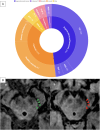Is the Swallow Tail Sign a Useful Imaging Biomarker in Clinical Neurology? A Systematic Review
- PMID: 39688317
- PMCID: PMC11802665
- DOI: 10.1002/mdc3.14304
Is the Swallow Tail Sign a Useful Imaging Biomarker in Clinical Neurology? A Systematic Review
Abstract
Background: Loss of dorsolateral nigral hyperintensity (DNH) in iron-sensitive sequences of Magnetic Resonance Imaging (MRI), also described as "swallow tail sign" (STS) loss, has shown promising diagnostic value in Parkinson's Disease (PD) and Atypical Parkinsonian Syndromes (APS).
Objective: To conduct a bibliometric analysis on substantia nigra MRI and a systematic review on the clinical utility of STS visual assessment on Susceptibility-Weighted Imaging in various clinical entities.
Methods: VOSviewer's keyword co-occurrence network was employed using Web of Science (WOS). Complying with the PRISMA statement, we searched MEDLINE, WOS, SCOPUS, ProQuest and Google Scholar for peer-reviewed studies conducted in vivo, excluding quantitative imaging techniques.
Results: DNH is a relatively novel parameter in substantia nigra MRI literature. Our SWI-focused review included 42 studies (3281 patients). Diagnostic accuracy of STS loss for PD/APS differentiation from controls and for Lewy Body Dementia differentiation from other dementias was 47.8-98.5% and 76-90%, respectively, with poorer capacity, however, in delineating PD from APS. STS evaluation in idiopathic REM sleep behavior disorder, a sign of prodromal PD, was typically concordant with nuclear scans, identifying subjects with high conversion risk. Iron deposition can affect STS in Multiple Sclerosis and STS loss in Amyotrophic Lateral Sclerosis is linked with multisystem degeneration, with poorer prognosis. In healthy individuals iron-induced microvessel changes are suspected for false positive results.
Conclusion: STS assessment exhibits potential in different settings, with a possibly intermediate role in the diagnostic work-up of various conditions. Its clinical utility should be explored further, through standardized MRI protocols on larger cohorts.
Keywords: biomarker; diagnosis; dorsolateral nigral hyperintensity; swallow tail sign.
© 2024 The Author(s). Movement Disorders Clinical Practice published by Wiley Periodicals LLC on behalf of International Parkinson and Movement Disorder Society.
Figures



References
Publication types
MeSH terms
Substances
Grants and funding
LinkOut - more resources
Full Text Sources
Medical
Miscellaneous

